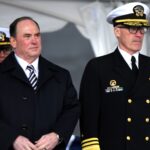
Huntington Ingalls Industries [HII] is using new digital model techniques to construct Ford-class aircraft carriers, starting with the future USS Enterprise (CVN-80), which is set to be the first vessel built entirely with digital models. The company is using the same technique for some submarine programs, a company official said last week. “Construction of the Enterprise has been ongoing for several years. We are actually going to be putting the first steel unit in the dry dock at the end…

 By
By 











